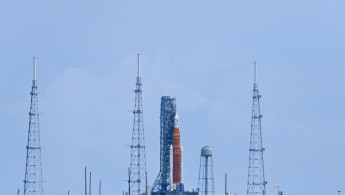NASA will not try new Moon rocket launch attempt in coming days
After scrapping a second attempt to get its new 30-story rocket off the ground due to a fuel leak, NASA announced on Saturday it will not try again during its current window of opportunity, which ends early next week.
Determined by the position of the Earth and Moon, the current launch period for NASA's Artemis 1 mission ends Tuesday and is "definitely off the table," said Jim Free, associate administrator for Exploration Systems Development, at a press conference Saturday, without confirming a new date.
The next possible launch windows according to NASA are September 19 to October 4 and then October 17 to 31.
Millions around the globe and crowds gathered on beaches in Florida had hoped to witness the historic blastoff of the Space Launch System (SLS), but a leak near the base of the rocket was found as ultra-cold liquid hydrogen was pumped in.
"The launch director waived off today's Artemis I launch," NASA said in a statement. "Multiple troubleshooting efforts to address the area of the leak... did not fix the issue."
The latest postponement "was the right decision after you develop this kind of leak," astronaut Victor Glover told reporters.
"These (are) really incredibly complex machines. When you see a scrub, people should gain confidence, not lose confidence."
The initial launch attempt on Monday was also halted after engineers detected a fuel leak and a sensor showed that one of the rocket's four main engines was too hot.
Next month?
The rocket will likely have to be hauled back into its assembly building to undergo certification tests that are carried out periodically.
Soon after Saturday's launch was scrubbed, NASA Administrator Bill Nelson said that a next attempt may have to be put off until mid-October because early next month a crew will use the Kennedy Space Centre to travel to the International Space Station.
Early in the morning, launch director Charlie Blackwell-Thompson had given the go-ahead to start filling the rocket's tanks with cryogenic fuel.
About three million litres of ultra-cold liquid hydrogen and oxygen were due to be pumped into the spacecraft, but the process soon hit problems, with Artemis mission manager Mike Sarafin later describing the issue as "not a manageable leak."
The purpose of the Artemis 1 mission is to verify that the Orion capsule, which sits atop the SLS rocket, is safe to carry astronauts in the future.
Mannequins equipped with sensors are standing in for astronauts on the mission and will record acceleration, vibration and radiation levels.
Apollo's twin sister
Once launched, it will take several days for the spacecraft to reach the Moon, flying around 60 miles (100 kilometres) at its closest approach.
The capsule will fire its engines to get to a distant retrograde orbit (DRO) of 40,000 miles beyond the Moon, a record for a spacecraft rated to carry humans.
The trip is expected to last around six weeks and one of its main objectives is to test the capsule's heat shield, which at 16 feet in diameter is the largest ever built.
On its return to Earth's atmosphere, the heat shield will have to withstand speeds of 25,000 miles per hour and a temperature of 5,000 degrees Fahrenheit (2,760 degrees Celsius) -- roughly half as hot as the Sun.
Artemis is named after the twin sister of the Greek god Apollo, after whom the first Moon missions were named.
Unlike the Apollo missions, which sent only white men to the Moon between 1969 and 1972, Artemis missions will see the first person of colour and the first woman step foot on the lunar surface.
A successful Artemis 1 mission would come as a huge relief to the US space agency, after years of delays and cost overruns.
A government audit estimates the Artemis program's cost will grow to $93 billion by 2025, with each of its first four missions clocking in at a whopping $4.1 billion per launch.
The next mission, Artemis 2, will take astronauts to the Moon without landing on its surface.
The crew of Artemis 3 is to land on the Moon in 2025 at the earliest, with later missions envisaging a lunar space station and a sustainable presence on the lunar surface.
A crewed trip to the red planet aboard Orion, which would last several years, could be attempted by the end of the 2030s.





 Follow the Middle East's top stories in English at The New Arab on Google News
Follow the Middle East's top stories in English at The New Arab on Google News


